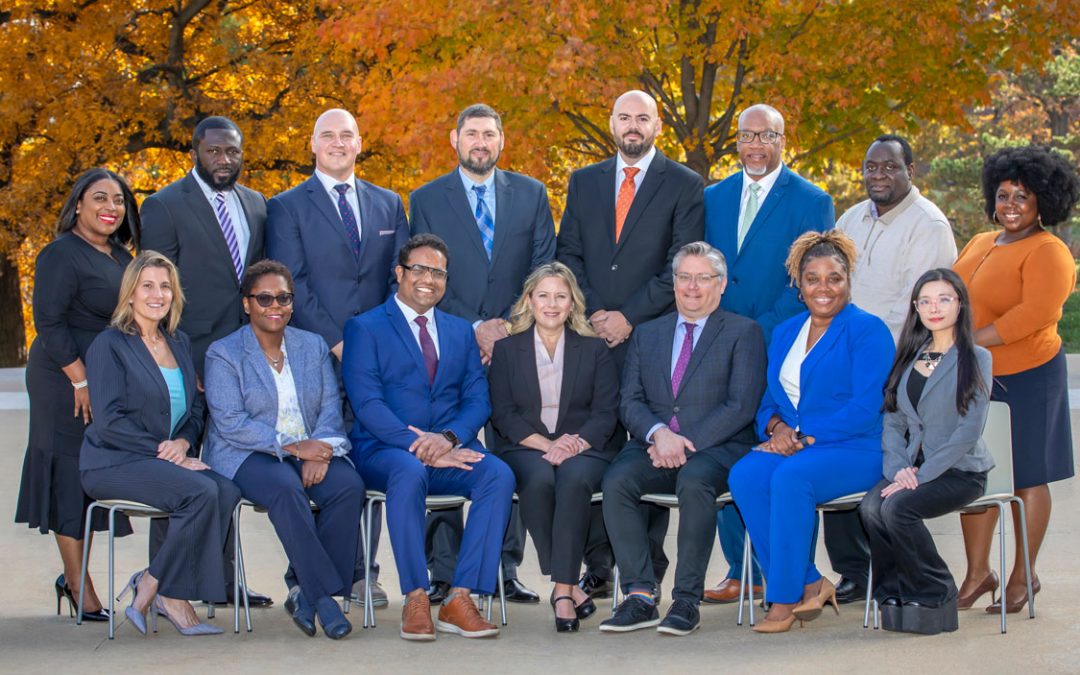
Donald K. Anderson Jr. says he loves the railroad industry and his passion for trains led him to become involved with UMSL and the St. Louis Mercantile Library. (Photo by August Jennewein)
Donald K. Anderson Jr. stands in front of an iconic railroad image. It’s a painting by Leslie Ragan that’s on display in the St. Louis Mercantile Library at the University of Missouri–St. Louis. A smile crosses his face as he talks about the artwork, the era, the trains.
The New York Central’s 20th Century Limited streamline locomotive dominates the painting’s foreground. Massive clouds of steam rise high into the air, nearly obscuring the Chicago Board of Trade Building, the city’s tallest skyscraper at the time.
“That picture, which first appeared as an illustration on a 1946 calendar, glorifies industry, it depicts the urgency of its time,” Anderson says. “My grandfather worked for the New York Central and put me in the seat of one of these type of locomotives at Union Station when I was 18 months old.”
Anderson talks railroading like a pro. The industry seems to run through his veins. He grew up taking railroad trips with his grandfather. They traveled to cities along the New York Central route and visited art museums.
So it was the trains, history and art that drew Anderson to the St. Louis Mercantile Library. It’s also what keeps him active as president of the library’s board of directors and a member of the Chancellor’s Council at UMSL. He’s also a member of two university giving clubs – the Pierre Laclede Society and 1963 Society.
His love affair with trains led him to the St. Louis Car Company (established in 1985 and doing business as Rail Cruise America). He served as president there from 1986 until its sale in 2005. The company operated a private luxury train across the United States. Trains also lured him to St. Louis County and the Museum of Transportation, where he served as vice present and president of the Transport Museum Association from 1985 to 1996.
An attorney specializing in real estate and land use, Anderson serves as a municipal judge in Ellisville, Mo., and provisional judge in Ballwin, Mo., and served as Ellisville’s city attorney for two decades.
The list of his civic duties, both past and present, is a long one, but his work with the FBI Citizens’ Academies and their national alumni association stands out.
The academies give business, civic and religious leaders a close look at the mission and capabilities of the FBI and build partnerships between the FBI and those leaders. There’s an academy aligned with each of the 56 FBI field offices around the country. Anderson completed the academy’s 10-course curriculum, which provides insights on how the FBI works, how it collects evidence and how it tracks down terrorists.
“On 9/11, I stayed up all night trying to figure out what I could do to help keep America safe,” Anderson says. “The FBI focuses on threats that challenge the foundations of American society.”
To join the FBI National Citizens Academy Alumni Association and its chapters, an individual must graduate from an FBI Citizens’ Academy. Association members are encouraged to get involved in their communities, share information on crime and crime prevention and work with law enforcement officials. Anderson has been a director of the national association since 2008 and its president since 2010.
He and Constance, his wife, live in Webster Groves, Mo.
“We’re within sight of the Union Pacific Mainline,” he says, returning to the subject of railroads.
New York Central’s 20th Century Limited (depicted in the Ragan painting) was a streamlined train that ran from New York’s Grand Central Terminal to Chicago’s LaSalle Street Station from 1902 to 1967. Anderson says it was known for its speed, sophistication and style. Passengers departing from New York walked to their cars on a plush red carpet designed specifically for the train. In fact, the phrase the “red carpet treatment” came into being thanks to the 20th Century Limited.
“Here’s a piece of that carpet, right here in the Mercantile Library,” Anderson says, pointing to a now-worn remnant of the famous carpeting.
It’s just one of the reasons he keeps coming back.
This story was originally published in the spring 2012 issue of UMSL Magazine.














